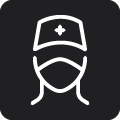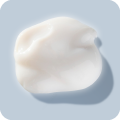About
Facial Angiofibroma

About
Facial
Angiofibroma
This graphic is for educational purposes only. TSC-associated Facial Angiofibroma symptoms may present differently for each person and at different points in their disease progression.
About Tuberous Sclerosis Complex
Facial angiofibroma may look similar to other skin conditions, such as rosacea or acne



This graphic is for educational purposes only. Skin conditions, including TSC-associated Facial Angiofibroma, may present differently for each person and at different points in time.

While facial angiofibroma may look like acne or rosacea, it is important to recognize that they are distinct conditions. Talk to your doctor about your condition and treatment options.
While symptoms may be treated effectively, there is no cure for facial angiofibroma, and treatment may need to be continued throughout the course of the condition.
Facial angiofibroma typically do not resolve on their own, but with a better understanding of facial angiofibroma associated with TSC and the way it affects you, you and your doctor can start managing your condition.

Not an actual patient. Individual conditions and results may vary.
Faces represent an important element of our social environment
As we look at someone, we typically examine the face starting with the area around the eyes and nose.
When we see someone with a facial defect, our eyes naturally focus on the imperfection first.
This may add to the daily emotional impact facial angiofibroma can have.
Treatment Options
for Facial Angiofibroma
Symptoms vary from person to person. If you’ve been diagnosed with facial angiofibroma, talk to your doctor about a treatment plan, including medications.

Laser therapy

Surgery

Cryotherapy
Physical removal may be used to treat facial angiofibroma
While surgery is not for everyone, it may be an option for people with moderate/severe facial angiofibroma.
Removal can include laser therapy, surgical excision, cryotherapy, and curettage for larger tumors.

Gel

Cream
Topical therapies may be effective and well-tolerated in the treatment of facial angiofibroma.
Close surveillance and intervention are generally recommended for TSC-related skin lesions that rapidly change in size and/or number; cause functional interference, pain, or bleeding; or inhibit social interactions.

Stories in Facial Angiofibroma
Watch as these patients with TSC-associated facial angiofibroma and their caregivers discuss their challenges, successes, and insights.

Find a TSC Center of Excellence or Clinic Near You
TSC Centers of Excellence (COE) and Clinics are healthcare facilities that specialize in the treatment and management of TSC, with many locations across the US. Use the map to enter your address below and find a COE or Clinic near you.

Find a COE or Clinic near you by talking with your healthcare provider and entering your location below
For informational purposes only. Not intended to replace your doctor’s medical advice or information from your plan about preferred doctors. Nobelpharma does not recommend or endorse any particular COE center or Clinic and search results may not include a comprehensive list of centers in your area.
1. University of Alabama Birmingham Tuberous Sclerosis Clinic
720 20th Street South, Birmingham, AL 35233
2. Arizona Pediatric Neurology & Neurogenetics Associates
3330 N 2nd St, Phoenix, AZ 85012
3. Children’s Rehabilitative Services Tuberous Sclerosis Clinic
3141 N. 3rd Avenue, Phoenix, AZ 85012
4. TSC Clinic at Arkansas Children’s
1 Children's Way, Little Rock, AR 72202
5. Tuberous Sclerosis Clinic at Loma Linda University Health Care
2195 Club Center Dr., Suite G, San Bernardino, CA 92408
6. Children’s Hospital Los Angeles Tuberous Sclerosis Clinic
4650 W Sunset Blvd, Los Angeles, CA 90027
7. UCLA TSC Clinic
300 UCLA Medical Plaza , Suite B200, Los Angeles, CA 90095
8. Benioff Children’s Hospital Oakland Tuberous Sclerosis Clinic
744 52nd St., Oakland, CA 94609
9. Children’s Hospital of Orange County TSC Clinic
1201 W. La Veta Ave., Orange, CA 92868
10. TSC Clinic at Rady Children’s Hospital San Diego
3020 Children's Way, San Diego, CA 92123
11. TSC Clinic at Lucille Packard Children’s Hospital
730 Welch Road, Palo Alto, CA 94304
12. TSC Clinic at Children’s Hospital Colorado & Univ of Colorado
13123 E 16th Ave, Aurora, CO 80045
13. TSC Clinic at Connecticut Children’s Medical Center
282 Washington St, Hartford, CT 06106
14. Tuberous Sclerosis Clinic at Children’s National Medical Center
111 Michigan Ave NW, Washington, DC 20010
15. TSC Clinic at Nicklaus Children’s Hospital Miami
3100 SW 62nd Ave, Miami, FL 33155
16. Advent Health Medical Group Epilepsy at Orlando
615 E Princeton St, Suite 540, Orlando, FL 32803
17. Neurocutaneous Disorders Clinic at Johns Hopkins Children’s
501 6th Ave S, St. Petersburg, FL 33701
18. H. Lee Moffitt Cancer Center - Tampa
3011 Holly Dr, Tampa, FL 33612
19. Children’s Healthcare of Atlanta
1400 Tullie Rd NE, Atlanta, GA 30329
20. University of Chicago Medical Center
5841 S Maryland Ave, Chicago, IL 60637
21. Tuberous Sclerosis Clinic Ann & Robert H. Lurie Children’s Hosp
225 E Chicago Ave, Chicago, IL 60611
22. TSC Clinic at University of Illinois at Chicago
120 N. Oak St., Hinsdale, IL 60521
23. University of Louisville, Norton Children’s Hospital
231 E Chestnut St, Louisville, KY 40202
24. Tuberous Sclerosis Clinic at Kennedy Krieger Institute Baltimore
707 N Broadway, Baltimore, MD 21205
25. University of Maryland
2200 Kernan Dr., Ambulatory Practice B, Room G374, Baltimore, MD 21207
26. The Carol and James Herscot Center for TSC - Boston
175 Cambridge Street, Suite 340, Boston, MA 02114
27. Multi-Disciplinary Tuberous Sclerosis Program – Boston
300 Longwood Avenue, Boston, MA 02115
28. TSC Clinic at Children’s Hospital of Michigan – Detroit
3901 Beaubien Blvd, Detroit, MI 48201
29. TSC Clinic at Helen DeVos Children’s Hospital – Grand Rapids
35 Michigan St NE, Suite 5201, Grand Rapids, MI 49503
30. Beaumont Health System Comprehensive TSC Clinic
18101 Oakwood Blvd., Dearborn, MI 48124
31. TSC Clinic Without Walls – St Paul, MN
2720 Fairview Avenue North., Suite 100, Roseville, MN 55113
32. Tuberous Sclerosis Clinic at Children’s Mercy Hospital
5808 W. 110th Street, Overland Park, KS 66211
33. Children’s Hospital, Saint Louis University School of Medicine
1465 South Grand Blvd., St. Louis, MO 63104
34. TSC Clinic at Northeast Regional Epilepsy Group
20 Prospect Ave, #800, Hackensack, NJ 07601
35. TSC Clinic at Institute of Neurology at St. Barnabas
200 S Orange Ave, #165, Livingston, NJ 07039
36. Montefiore Medical Center
3415 Bainbridge Ave, 4th Floor Bronx, NY 10467
37. TSC Center at the Columbia University Irving Medical Center
630 West 168th Street, New York, NY 10032
38. The TS Center at New York University Langone Medical Center
223 East 34th Street, New York, NY 10016
39. Atrium Healthcare TSC Clinic at Levine Children’s Hospital
1000 Blythe Blvd, Charlotte, NC 28203
40. Duke Medical Center – Durham, NC
2301 Erwin Rd, Durham, NC 27710
41. Wake Forest Baptist Medical Center Tuberous Sclerosis Clinic
Medical Center Blvd, 9th Fl,Pediatrics, Winston-Salem, NC 27157
42. TSC Clinic at Akron Children’s Hospital - Akron
214 W Bowery St, Akron, OH 44308
43. The Tuberous Sclerosis Clinic - Cincinnati
3333 Burnet Ave, Cincinnati, OH 45229
44. TSC Clinic at The Cleveland Clinic - Cleveland
9500 Euclid Ave, Cleveland, OH 44106
45. TSC Clinic at Children’s Hospital, Univ Hospital Cleveland
11100 Euclid Ave, Cleveland, OH 44106
46. TSC Clinic at Nationwide Children’s Hospital – Columbus, OH
700 Children's Dr, Columbus, OH 43205
47. TSC Clinic at Dayton Children’s Hospital – Dayton, OH
1 Children's Plaza, Dayton, OH 45404
48. University of PA (HUP)
3400 Spruce Street, Philadelphia, PA 19104
49. Children’s Hospital of PA (CHOP)
3401 Civic Center Blvd., Philadelphia, PA 19104
50. Children’s Hospital of Pittsburgh TS Clinic
1 Children's Hospital Drive, 4401 Penn Ave, Pittsburgh, PA 15224
51. TSC Clinic at Prisma Health – Columbia SC
8 Richland Medical Park Dr, #420, Columbia, SC 29203
52. TSC Center of Excellence at Le Bonheur Children’s Hospital
800 South Church Street, Suite 104, Jonesboro, AR 72401
53. TSC Clinic at Monroe Carell, Jr. Children’s Hospital at Vanderbilt
2200 Children's Way, 9th Floor, Nashville, TN 37232
54. Children’s Care clinic at Dell Children’s Medical Center - Austin
4900 Mueller Blvd, Austin, TX 78723
55. Texas Scottish Rite Hospital for Children - Dallas
2222 Welborn St, Dallas, TX 75219
56. Cook Children’s Clinic for Tuberous Sclerosis Complex
1500 Cooper Street, Fort Worth, TX 76104
57. Univ of Texas-Memorial Hermann TSC Center of Excellence
6410 Fannin St, Houston, TX 77030
58. Tuberous Sclerosis Clinic at Texas Children’s Hospital – Houston
3023 Kirby Dr, Houston, TX 77098
59. University of Utah TS Clinic- Salt Lake City, UT
81 Mario Capecchi Drive, Salt Lake City, UT 84113
60. The University of Virginia (UVA) Tuberous Sclerosis Clinic
1215 Lee Street, Charlottesville, VA 22903
61. Virginia Commonwealth University (VCU) Health System
3600 W. Broad Street, Suite 115, Richmond, VA 23230
62. TSC Clinic at Seattle Children’s Hospital
4800 Sand Point Way NE, Seattle, WA 98105
63. Swedish Neuroscience Institute – Seattle, WA
550 17th Ave, Suite 540, Seattle, WA 98122
64. Neurofibromatosis & RASopathy Program Children’s Hospital
8915 W. Connell Ct., Milwaukee, WI 53226



















